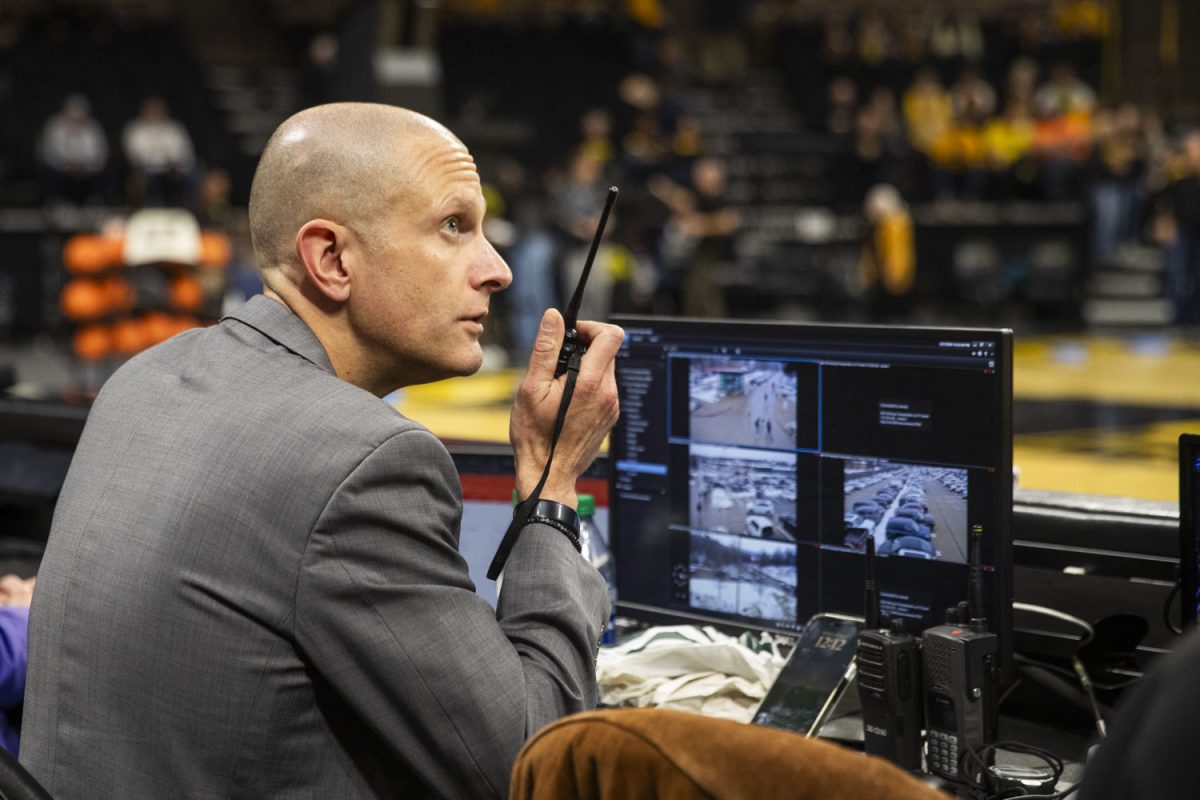Months of prep will soon turn into a weekend of memories.
Iowa women’s basketball received the No. 1 seed in the NCAA Tournament, giving the Hawkeyes hosting rights for a “First Four” game and the first two rounds.
Behind the scenes, the University of Iowa staff has been preparing to host the tournament since last fall. One of those staff members who makes hosting possible is Josh Berka, the assistant athletics director of event management and sports camps.
Berka started by securing hotel room blocks around the community for visiting teams. Once the new year rolled around, Iowa submitted its bid to the NCAA to host the first and second rounds. The NCAA requires a hosting site to meet specific safety, facility, and financial standards, such as ADA seating and accessibility, number of locker rooms, and electrical components that allow broadcast TV, like ESPN, to plug in its mobile trucks.
She said the athletics department has a “great partnership” with UI Campus Safety, who collaborates with local law enforcement, to ensure a safe and secure environment for everybody. The visiting team locker rooms in Carver-Hawkeye Arena along with another Iowa locker room, such as men’s basketball or volleyball, will be utilized. The Hawkeye women will use their regular locker room.
He added that arena capacity “isn’t necessarily part of [the requirements].” That’s something Iowa wouldn’t have to worry about anyway because over 15,000 seats inside Carver will be filled as the Hawkeyes battle for a berth to the Sweet 16. There was no public on-sale after brackets were announced on March 17 because Iowa season ticket holders snatched up every available seat in 30 minutes. Each team traveling to Iowa City — Princeton, West Virginia, UT Martin, and Holy Cross — is required to purchase at least 100 all-session tickets. Iowa City’s first-round attendance last year was higher than nine of the 16 sites’ first and second-round combined attendance, according to Hawkeye Sports.
“We’ve been so fortunate in the last several years to have hosted this many times that we’re not recreating the wheel by any stretch,” Berka said. “So, folks are invested. They know what to do. And they know what it takes to put forth the best site that we possibly can and be the best site in the country.”
Berka said the biggest change to tournament preparation was when the women’s tournament started using March Madness branding in 2022. Since then, the NCAA has made “little tweaks” to improve its hosting sites.
As far as the March Madness branding goes, Berka said the NCAA shipped banners to the university this week for him and his staff to hang. Because of the unique layout of Carver and its single concourse, Berka and his team have been discussing the best places to hang the banners for a while.
The March Madness logos you see on the court during the first two rounds, however, are “superimposed,” Berka said.
“Because of the turnaround and just not knowing logistically where everything’s going to go until Sunday night, there’s no core graphics that are actually sent to each site,” Berka said. “And part of that is also from the standpoint for the student-athletes to not have a slip hazard.”
He clarified that for the Sweet 16, Elite Eight, and Final Four, there will be unique logos specific to each hosting site stuck on the court.
With all the attention Caitlin Clark and the Hawkeyes have brought to women’s basketball, Berka is expecting many media contingencies to be in Iowa City. In the final game of the regular season against Ohio State, there were nearly 300 credentialed media members at Carver.
This is when Bailey Turner, Iowa women’s basketball’s sports information director, comes in. Since Selection Sunday, Turner has spent eight to 10 hours at Carver prepping for this weekend. He predicts 120-130 media members, including TV, will be covering the games.
Turner said the hardest part is making sure everyone gets a spot and it’s fair, but he has some help from the NCAA, as each hosting site is required to have an NCAA media coordinator. According to the NCAA, its media coordinators should collaborate with “the sports information directors of each participating team to provide smooth media operations at each site, for the media, the coaches, and the student-athletes.”
During Iowa games, Turner is responsible for tracking the postgame notes and any historical data that will be sent out to media members after the final buzzer. With a few minutes left in a game, Turner facilitates which players will be interviewed and then gets everybody to the press conferences and locker rooms.
Turner said he is mainly responsible for the Iowa beat writers, who already know how to navigate the arena. The only thing that’s different for the Hawkeye beat writers might be where they sit during a game. Along with press row above Iowa’s bench, Berka said there will be more media seating courtside.
The chairs you would typically see fans sit in on the opposite side of the team benches will be gone and replaced with a media table. Berka said the university is also getting a larger number of photographer requests than in previous years, so there will be additional space on the ends of the court for them.
After the first two rounds are complete, the NCAA will get feedback from the participating teams at each host site to assess the student-athlete experience. Berka said he and his team always welcome feedback from anyone they can to continue to “provide the best experience for student-athletes in the country.”
“Knowing the opportunity our student-athletes have to perform, compete, and excel at the highest level and to be able to do it on their home court and not having to worry about anything else but going out and doing their best – that’s the reason why we do what we do,” Berka said.



